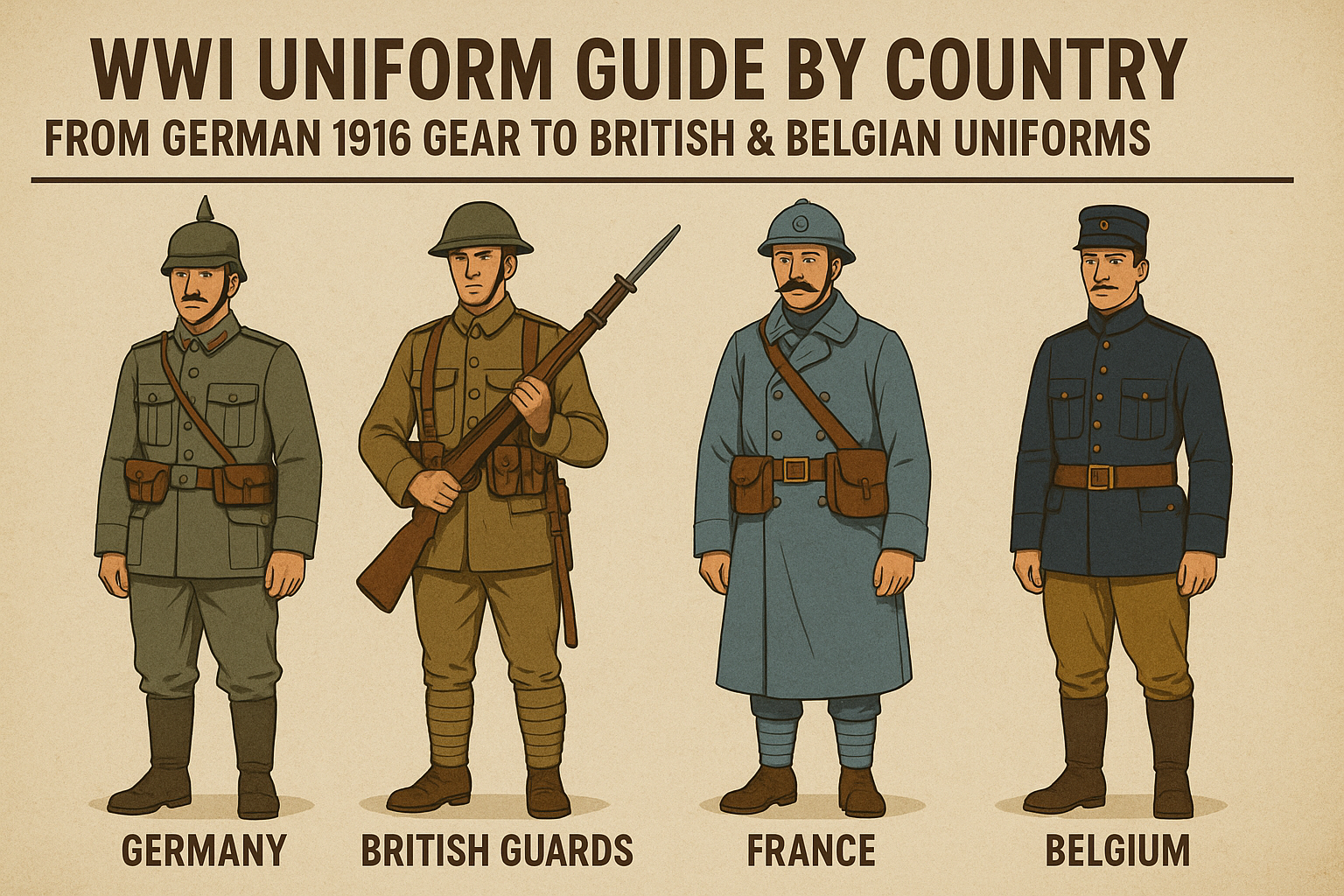
WWI Uniform Guide by Country: From German 1916 Gear to British & Belgian Uniforms”
Published on Jun 22, 2025
WWI Uniforms by Country: A Guide to World War 1 Military Attire
World War I was a turning point in modern warfare—not just in technology and strategy but also in the appearance and functionality of military uniforms. The conflict saw a dramatic evolution in military clothing, influenced by changing tactics, industrial capabilities, and climate conditions. In this article, we take a closer look at WWI uniforms by country, providing collectors and enthusiasts with insights into iconic attire like the German WW1 uniforms for sale, Belgian WW1 uniforms, and the distinctive British Guardsman uniform.
1. German WW1 Uniforms (Deutsches Heer)
Germany’s military uniforms during World War I are among the most recognizable. They evolved significantly throughout the war due to practical needs on the battlefield.
Early War: Pre-1916 German Uniforms
The early WWI German infantry uniform, known as the M1910 Feldgrau, featured a grey-green wool tunic with red piping and Pickelhaube (spiked helmet). While visually striking, these uniforms were not well-suited for trench warfare. The shiny helmets and bright trims made soldiers easy targets.
WW1 German Uniform 1916 Update
By 1916, Germany transitioned to the M1916 uniform, which introduced a more subdued design. The iconic Stahlhelm (steel helmet) replaced the Pickelhaube, offering better protection. The tunic lost much of its colorful detailing, opting instead for a more utilitarian look. These changes aimed to improve camouflage and survivability in the trenches.
Collectors today often look for German WW1 uniforms for sale that reflect this transition, especially those featuring authentic or replica M1916 helmets and tunics.
2. Belgian WW1 Uniform
When Germany invaded Belgium in 1914, the Belgian Army mobilized with limited modern equipment. Their uniforms were outdated compared to other major powers at the time.
Belgian Infantry Attire
The typical Belgian WW1 uniform consisted of a dark blue tunic and trousers, a color that proved impractical in modern combat. Eventually, Belgium adopted a more neutral khaki tone similar to that of the French and British. Headgear evolved from the traditional kepi to the Adrian-style helmet shared with French forces.
The Belgian uniform is less common among collectors, making it a unique addition for those who focus on lesser-known forces. Reproductions of Belgian WW1 uniforms are gaining popularity among reenactors due to their historical significance.
3. British Guardsman Uniform
The British Army during WWI is often associated with its efficient and practical uniform design. One of the most iconic variations was the British Guardsman uniform.
Key Features of the British Guardsman Uniform
The Guards Regiments were known for their impeccable discipline and striking appearance. Their WWI uniform featured a khaki wool Service Dress tunic, breeches, and puttees (leg wrappings). The Guardsman uniform maintained a cleaner, more formal appearance even in the trenches. Officers wore Sam Browne belts and often had better-quality materials in their uniforms.
The headgear for most soldiers was the Brodie helmet, a steel pot-shaped helmet introduced in 1915. The Guards maintained distinctive insignias and regimental badges that helped identify their elite status.
Today, many militaria enthusiasts seek out the British Guardsman uniform for its historical prestige and quality craftsmanship.
4. French WW1 Uniforms
Although not a focus of this article, it's worth briefly mentioning that France’s early war uniforms—blue coats and red trousers—quickly proved ineffective. By mid-war, they switched to the more muted “horizon blue” to blend in with the environment.
5. Italian Uniforms and the WWI Italian Helmet
Italy joined the war in 1915 on the side of the Allies. Their uniforms were practical but reflected the mountainous terrain in which much of the fighting occurred.
WWI Italian Helmet – The Adrian Design
Italy adopted a modified version of the French Adrian helmet, painted in a green-grey tone. Their uniforms were similarly functional, typically consisting of grey-green wool tunics and capes suited for alpine warfare.
The WWI Italian helmet remains a favorite among collectors for its unique crest and historical value. Often mistaken for French helmets, Italian versions carry national insignias or crests that set them apart.
How WWI Uniforms Influenced Modern Military Attire
The changes made during WWI laid the groundwork for military uniforms in the 20th century:
- Camouflage: Nations realized the importance of blending in, moving from colorful attire to muted, earth-toned uniforms.
- Helmet Design: Helmets became a necessity, with each major power designing its own version to improve head protection.
- Functional Wear: Uniforms became more utilitarian with less emphasis on parade aesthetics and more on battlefield durability.
Collecting and Reproducing WWI Uniforms
For historians, reenactors, and collectors, owning a piece of WWI military attire is both a passion and a tribute to those who served. At Paddelaters.com, we specialize in offering German WW1 uniforms for sale, as well as reproductions and accessories from other countries involved in the Great War.
Whether you’re interested in:
- Authentic Belgian WW1 uniforms
- Full sets of British Guardsman uniforms
- WWI helmets like the German Stahlhelm or Italian Adrian helmet
We provide quality, historically accurate items that meet the needs of collectors and enthusiasts alike.
Conclusion
The uniforms worn during WWI tell the story of a world in transition—between old-world traditions and the demands of modern warfare. By exploring WWI uniforms by country, we gain a deeper appreciation of the era and its people.
Whether you're collecting German WW1 uniforms for sale, researching for a project, or preparing for a reenactment, understanding the historical context and design of these uniforms is key. Browse our catalog at Paddelaters.com and bring history to life with authentic gear from the Great War.
